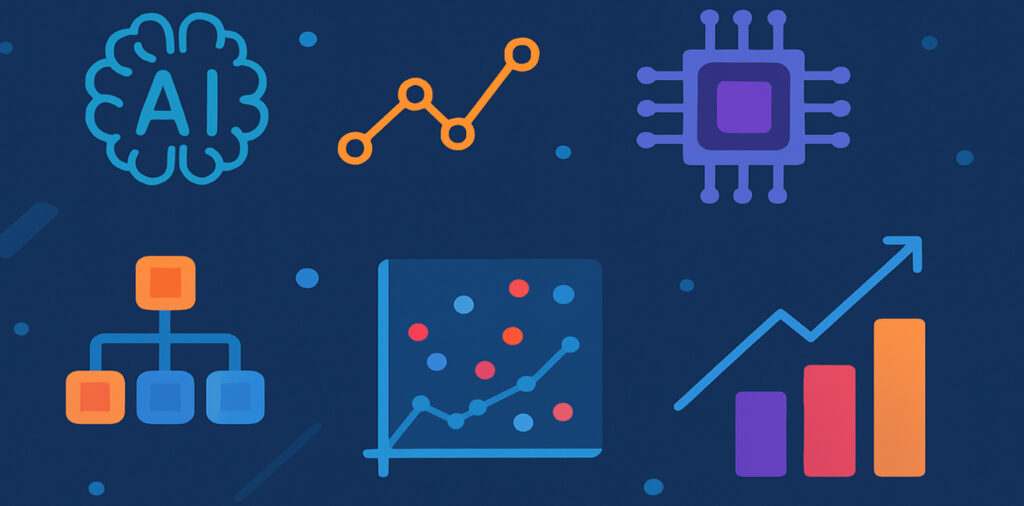
Artificial Intelligence (AI) is one of the most relevant technological advances of recent years. Whether it’s built into search engines, recommendation systems, or productivity tools, AI is increasingly present in how we interact with technology.
For those of us working in data, marketing, or tech-related fields, AI offers much more than convenience, it provides a strategic advantage. One of the most exciting and impactful applications of AI is in the field of data analytics. In this post, we’ll explore how AI, specifically through Machine Learning (ML), can elevate your analytical work, uncover hidden insights, and drive smarter decisions.
What is Machine Learning?
Machine Learning is a type of AI that involves training algorithms to identify patterns and make decisions based on data. These models don’t follow hard-coded rules, instead, they learn from examples. ML is widely used in industries ranging from finance to healthcare, and it’s a game changer in digital marketing and analytics.
Some of the most common machine learning tasks in data analytics include:
Predictive Analysis
This involves using historical data to predict future outcomes. For example, ML models can help forecast:
- User churn
- Seasonal traffic spikes
- Future purchase trends
- Campaign performance
Clustering
Clustering is the process of grouping users with similar behaviors or characteristics. It’s especially useful when you don’t know in advance how many segments exist. With clustering, you can:
- Identify audience segments
- Spot anomalous behavior
- Separate high-intent users from low-quality traffic
Classification
Classification models are used to assign categories to new data points. This can be used for:
- Predicting if a user is likely to convert
- Categorizing leads as high or low quality
- Flagging unusual events in data streams
How Do Machine Learning Models Work?
The process of working with machine learning starts with one thing: data.
Define your objective
Before anything else, clearly define what you want to achieve. Your goal will determine everything from the data you gather to the model you use.
Gather and Prepare Your Dataset
Your data source could come from:
- Google Analytics 4
- Adobe Analytics
- Google BigQuery
- SQL databases
- A simple CSV file
Once you have your data, you’ll need to clean and transform it. This step is crucial to ensure your model produces meaningful results. Common data preparation tasks include:
- Removing or filling missing values
- Dropping irrelevant or redundant columns
- Encoding categorical variables
- Scaling numeric values
- Balancing the dataset
Choose a Model
Based on your objective, select an appropriate algorithm. Some common ML models include:
| Model | Use Case |
|---|---|
| Linear Regression | Predicting numerical outcomes like revenue |
| KMeans | Grouping similar users or products |
| DBSCAN | Detecting natural clusters and outliers |
| Decision Trees | Rule-based classification |
| Random Forest | More robust classification with multiple decision trees |
| Logistic Regression | Predicting binary outcomes |
Each model has different requirements and behaviors, so understanding the logic behind them is key to choosing the right one.
Train and Evaluate
Once your dataset is prepared and your model is selected, it’s time to train the model, this means feeding it historical data (examples) so it can learn patterns. After training, you test its performance using a separate dataset (validation or test sets) to ensure it generalizes well.
Turning Insights Into Action
The ultimate goal of using AI in data analytics is to generate actionable insights. Here are a few examples of how machine learning can directly impact your marketing and analytics strategies:
- Personalization: Segment users based on behavior and tailor content accordingly.
- Campaign Optimization: Predict which users are more likely to convert and retarget them.
- Traffic Quality Analysis: Use clustering to filter out noise or low-quality sessions.
- Trend Forecasting: Anticipate changes in user behavior before they happen.
By automating pattern recognition and decision-making, ML models help you go beyond reporting into strategic planning.
Final Thoughts
Artificial Intelligence it’s a practical tool that, when used well, can transform how you analyze data and understand your users. Whether you’re working with a massive dataset or exploring a smaller use case, ML techniques like clustering, prediction, and classification can surface insights that are otherwise difficult to detect.